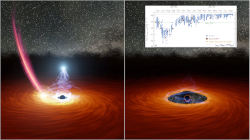 HEAPOW: The Changeling (2020 Jul 20)
HEAPOW: The Changeling (2020 Jul 20)
Supermassive black holes at the centers of some galaxies produce huge amounts of high-energy radiation (trillions of times brighter than the total power output by the Sun) by swallowing matter from a hot swirling disk of material around them. No one really knows how these accretion disks form, how long they last, or how stable they are. This accretion process is vitally important to the evolution of galaxies and the "cosmic web" of both flavors of matter (light and dark) that hold the material Universe together. So scientists spend a lot of time studying this accretion process by looking at the high energy radiation produced by the accretion disk. Sometimes strange things happen. In a small number of cases, scientists have seen sporadic variations which seem to indicate that, for some period of time, the accretion process becomes totally disrupted. No one knows why, and because these rare events happen randomly, they've been hard to catch in the act. Until now, that is. Using the NICER and Swift X-ray observatories and other X-ray satellites, scientists have now been able to watch in detail how the X-ray emission produced by the accretion process changes with changing accretion rate. The image above shows an illustration of the accretion disk around a black hole in an otherwise non-descript galaxy called 1ES1927+65. The inset shows how the X-rays from this accretion disk varies over a timespan of more than a year of X-ray observations. A dramatic dip can be seen in the X-ray emission in the summer of 2018 (with significant variations in the X-ray power occuring over times as short as 8 hours), and a gradual recovery in the fall of 2018. This extraordinary evidence is a real puzzle and requires an extraordinary explanation. Astronomers think that this dip was likely produced by a star that wandered too close to the black hole, and, as it got torn to shreds by the black hole's incredible gravitational pull, bits of the broken star blew apart the flow of matter from the inner accretion disk for a period of a few months. The panel on the left in the illustration purports to show a streak of debris from the shredded star falling on the accretion disk and destroying the inner accretion disk (as shown in the panel on the right).
JPL: Runaway Star Might Explain Black Hole's Disappearing Act
viewtopic.php?t=40789
| << Previous HEAPOW | High Energy Astrophysics Picture of the Week | Next HEAPOW >> |